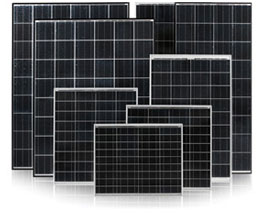Energía Solar Energy Sonnenenergie
Equipos Equipment Geräte
Paneles solares fotovoltaicos Kyocera

Kyocera Solar Electric Modules
Solar Modules Power Characteristics:
The current and power output of photovoltaic modules are approximately proportional to sunlight intensity. At a given intensity, a module's output current and operating voltage are determined by the characteristics of the load. If that load is a battery, the battery's internal resistance will dictate the module's operating voltage.
A module which is rated at 17 volts will put out less than its rated power when used in a battery system. This is because the working voltage will be between 12 and 15 volts. As wattage (power) is the product of volts times amps, the module output will be reduced. For example: a 50 watt module working at 13.0 volts will produce 39.0 watts (13.0 volts x 3.0 amps = 39.0 watts). This is important to remember when sizing a PV system.
Shading:
PV modules are very sensitive to shading. Unlike a solar thermal panel which can tolerate some shading, many brands of PV modules cannot even be shaded by the branch of a leafless tree.
Shading obstructions can be defined as soft or hard sources. If a tree branch, roof vent, chimney or other item is shading from a distance, the shadow is diffuse or dispersed. These soft sources significantly reduce the amount of light reaching the cell(s) of a module. Hard sources are defined as those that stop light from reaching the cell(s), such as a blanket, tree branch, bird dropping, or the like, sitting directly on top of the glass. If even one full cell is hard shaded the voltage of that module will drop to half of its unshaded value in order to protect itself. If enough cells are hard shaded, the module will not convert any energy and will, in fact, become a tiny drain of energy on the entire system.
Partial-shading even one cell of a 36-cell module, such as the KC120, will reduce its power output. Because all cells are connected in a series string, the weakest cell will bring the others down to its reduced power level. Therefore, whether ½ of one cell is shaded, or ½ a row of cells is shaded as shown above, the power decrease will be the same and proportional to the percentage of area shaded, in this case 50%.
When a full cell is shaded, it can act as a consumer of energy produced by the remainder of the cells, and trigger the module to protect itself .The module will route the power around that series string. If even one full cell in a series string is shaded, as seen on the right, it will likely cause the module to reduce its power level to ½ of its full available value. If a row of cells at the bottom of a module is fully shaded the power output may drop to zero. The best way to avoid a drop in output power is to avoid shading whenever possible.
Tilt Angle:
To capture the maximum amount of solar radiation over a year, the solar array should be tilted at an angle approximately equal to a site's latitude, and facing within 15° of due south. To optimize winter performance, the solar array can be tilted 15° more than the latitude angle, and to optimize summer performance, 15° less than the latitude angle. At any given instant, the array will output maximum available power when pointed directly at the sun.
To compare the energy output of your array to the optimum value, you will need to know the site's latitude, and the actual tilt angle of your array-which may be the slope of your roof if your array is flush-mounted. If your solar array tilt is within 15° of the latitude angle, you can expect a reduction of 5% or less in your system's annual energy production. If your solar array tilt is greater than 15° off the latitude angle, the reduction in your system's annual energy production may fall by as much as 15% from its peak available value. During winter months at higher latitudes, the reduction will be greater.
Azimuth Angle and Magnetic Declination:
If a south-facing roof is unavailable, or the total solar array is larger than the area of a south-facing roof section, an east or west-facing surface is the next best option. Be aware that solar power output decreases proportionally with a horizontal angle, or "azimuth," greater than 15° from due south. The decrease in annual power output from a latitude-tilted east or west-facing array may be as much as 15% or more in the lower latitudes or as much as 25% or more in the higher latitudes of the United States. Avoid directing your tilted solar panels northwest, north or northeast, as you'll get little power output.
Magnetic declination, the angle difference between magnetic south and true solar south, must also be taken into account when determining proper solar array orientation. If a magnetic compass alone is used to determine where to point the array, you may not capture the maximum amount of solar radiation.
Quito, Ecuador, Sudamérica
CC

